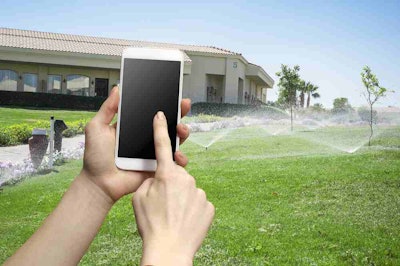
According to online survey research collected from Orbit, almost 70 percent of Americans claim they know how long they should water their lawn, but the report also shows that Americans drastically underestimate how much water they use when irrigating. Seventy-seven percent believe they use anywhere between 1 to 250 gallons of water per quarter acre.
When talking to customers about installing smart irrigation systems, take a look at what the experts have to say about these tools and the environmental, sustainable and water-saving benefits that accompany them.
What is a smart irrigation system?
According to Donn Mann, specification manager and public agency account manager with Rain Bird, the term ‘smart irrigation system’ really refers to more than one particular item.
“Let me first take a step back and indicate that ‘smart irrigation systems’ has become a bit of a catchphrase; it is not specific to any one component or approach,” Mann said. “It kind of caught on when a series of controllers called smart controllers started to come on board, and smart controllers are, essentially, pulling in weather data into the controller and adjusting the controller, much like a thermostat on a heating and air conditioning system.”
Instead of having a basic, time-based program that will run regardless of what the weather is doing, Mann says systems like these will adjust the time and days it will run according to the demand or need of irrigation based on the weather.
Many components make up an irrigation system, and Mann says parallel to smart irrigation controllers, there has also been a push on high-efficiency nozzles. Mann says these nozzles play into what’s called the distribution of uniformity (DU), which describes how evenly water is distributed from the sprinkler nozzle to its furthest distance of throw. Mann says the significant advancements that have taken place with DU have improved the efficiency of the irrigation system.
“Those two together kind of make up a smart irrigation system or a high-efficiency irrigation system,” Mann said. “It’s not really one or the other; it’s a bit of the combination of the two.”
In spring of 2014, Rachio says it launched its first generation controller and started its journey into the smart irrigation game.
“Difficult to use and reliant on physical input, traditional ‘dumb’ controllers scrambled to make antiquated functionality fit modern needs; however, Rachio was intentionally developed to leverage cutting-edge technology for a smarter watering solution,” said Eric Petrek, marketing lead for Rachio.
Petrek says that after the initial launch in 2014, Rachio saw an immediate attraction, especially with smartphone users and yard enthusiasts.
Rain Bird has had smart irrigation technology in their golf courses and larger commercial applications since the late 60s/early 70s. Mann says since then, the technology has advanced and the cost has come down, which allows Rain Bird to now offer a residential version of these controllers.
Demographics and popularity
As to why smart irrigation systems have become so popular, Petrek says a few key benefits drive these systems.
First, he says, is the convenience and ease systems like these offer by giving users the mobile control option. The second benefit Petrek says these systems bring is the ability to use smart scheduling that adjusts to the weather, which he says can ultimately save customers money on their water bills.
The final benefit Petrek says these systems offer is the possibility that more customers will take an interest in them as more smart home devices, such as Amazon Alexa, make their way on the scene.
“Born in the age of cloud technology, Rachio connects to the internet to receive dynamic schedule updates that automatically adjust to changing weather data, tailor watering to the specific needs of each yard and automatically optimize watering for efficiency,” Petrek said.
According to Orbit, only 7 percent of Americans surveyed owned a smart sprinkler system, despite concerns about wasting water; 38 percent said they didn’t see a need for a smart sprinkler.
Before technology came into play, Mann says users would err on the side of overwatering to make sure their lawns were sufficiently moist.
“As the cost of water (went) up and as people have become more aware of water usage, the desire to use the appropriate amount of water is what really has driven this,” Mann said. “A lot of it also is in combination with more of the green movement in general. So, irrigation has kind of ridden the coattails of that, as far as people wanting to do the right thing with using water.”
Mann adds that many cities, states and water purveyors now mandate that irrigation systems meet a certain level of efficiency. He says location is a key player when gauging how popular the use of smart irrigation systems is, and Rain Bird offers their services nationwide.
Orbit also found that 44 percent of Americans, even though they are concerned about water usage, believe the government shouldn’t place limits on residential water usage; 22 percent felt the government should, however, be involved in regulating residential water usage during times of drought.
Mann says Rain Bird has also noticed a younger demographic taking interest in the smart controller because there is a mobile app that accompanies it.
“One of the challenges with irrigation is, traditionally, you had to be in front of the controller in order to know if there’s anything going on,” Mann said. “But now with phone apps and other things, you have remote access to it wherever you are. So, people are way more in touch with what’s happening with the irrigation system.”
Petrek says Rachio has noticed the strongest growth for these systems in areas that have seen the largest water scarcity issues.
“When you’re in a water scarce region, you’ve got to be smart with every gallon, and a smart sprinkler controller makes a large impact to remove that waste,” Petrek said. “The ease of use of a smart sprinkler controller makes them appealing to all demographics, though.”
Benefits, drawbacks and selling
When selling these smart irrigation systems to contractors, Rain Bird’s tactic is to place emphasis on the remote access ability these systems offer.
Mann says that since contractors are more concerned with the ability to manage these systems remotely for time efficiency purposes, putting more emphasis on the labor-saving element can help drive home a sales pitch.
For a contractor trying to sell these systems to a customer, Mann recommends emphasizing the cost benefits of having a smart irrigation system in play.
“We’re using 30-50 percent less water,” Mann said. “So, if they’re paying for the water or if they’re environmentally conscious about how much water they’re using, those are the triggers that would intrigue them.”
As far as drawbacks for the systems, Mann and Petrek both believe there really aren’t any.
“It’s taking existing components and adapting to information that’s available,” Mann said. “And when we talk about high-efficiency nozzles, no, there’s really no negative to that either because it’s just improving the efficiency.”
“Smart sprinkler controllers give you access to your sprinklers wherever and whenever you need from your phone,” Petrek said. “They also create dynamic schedules that adjust due to weather and seasonal changes based on your plants, soil, sun exposure and more. This creates a customized schedule that is custom tuned to your yard to make sure your plants get just the right amount of water at just the right time.”
Looking to the future, Petrek believes that popularity for systems like these will only continue to grow, especially with the amount of new feature potential that comes with technological devices like these.
An update Petrek says Rachio has added to its Rachio 3 smart sprinkler control is a wireless flow meter, which he says allows users to know exactly how much water they’re using, as well as give them protection against wasting water due to leaks, broken pipes, broken heads and other problems with the system.











